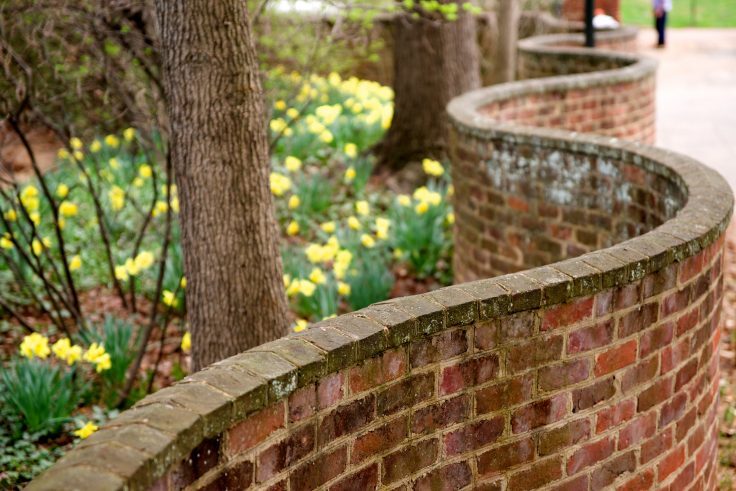A longtime architectural history professor at the University of Virginia is questioning the idea that the Thomas Jefferson-designed "serpentine wall" surrounding the university's lawn was built to hide slave labor, a claim made by activists who successfully pushed the school to remove a reference to the wall from its official logo.
Professor emeritus Richard Guy Wilson said that while the curved brick structures enclosed the professors’ gardens, where slaves likely worked, Jefferson did not intend for the walls to hide slaves from the public.
"I don’t think they were made for the explicit purpose of hiding slaves," Wilson told the Washington Free Beacon. "Not to say there weren't enslaved African Americans working there, but I don't think it was there to hide them away."
UVA's decision to remove the walls from its logo comes as historical structures and figures across the country are under attack by activists who have called for the removal of all statues of people—including those of presidents—who have ties to slavery. New York City council members have called for the removal of Jefferson's statue from New York's city hall because he was a slave owner. Other logos, such as Quaker Oats's Aunt Jemima pancake mix and syrup, are dropping their images and namesakes based on claims that the branding is based on racial stereotypes.
UVA came under fire last week for its new "V-sabres" logo, which was unveiled in April. Second-year student Lauren Cochran and assistant media studies professor Meredith Clark claimed the famous curved garden walls—depicted in the sabre handles’ ridged detailing—were used to conceal slaves and that the logos should be redesigned. Athletic director Carla Williams, who joined the school in 2017, said she decided to alter the logo after she was "made aware of the negative connotation between the serpentine walls and slavery."
Jefferson's serpentine wall design was influenced by gardens in Great Britain, where curved walls have been used for centuries to create strong barriers while saving on material. Unlike straight walls, serpentine walls can stand tall with only one layer of brick. The design allows gardeners more control over the sunlight plants receive. Jefferson's original design notes for the wall, housed at the university library, show he calculated the precise number of bricks he could avoid purchasing by opting for the serpentine style of wall.
Rather than being used to keep slaves out of sight, Wilson proposed the walls were built to keep rowdy students from wrecking the professor's gardens.
"Early students were a riotous bunch of elite, young, white men," Wilson said. "There were the usual problems of a little too much hooch and fooling around. I think they were put up to keep the damn students out of the gardens so they didn’t muck it up."
Though Jefferson, the founder of UVA and the country’s third president, is most famous for penning the Declaration of Independence, his work in architecture is also notable. His architectural style influenced the design of the Capitol Building, the White House, and other buildings in Washington, D.C. In 1987, Jefferson’s home, Monticello, and the University of Virginia’s campus were together named a UNESCO World Heritage site.
Wilson, who earned his Ph.D. in American culture, art, and architectural history at the University of Michigan in 1972, joined the University of Virginia’s staff in 1976. He specializes in art and architecture from the 18th through 21st centuries, including that of Thomas Jefferson. In 2007, Wilson helped design a plaque commemorating the slaves who built the university in the early 19th century. Between 2013 and 2018, Wilson worked on former president Teresa Sullivan’s President’s Commission on Slavery and the University, in which university faculty researched the schools history of using slave labor.
As a prominent feature of campus, the serpentine walls have been used as a symbol for some campus organizations. The Serpentine Society is one such group, providing a community for LGBTQ students and alumni.
President Brendan Maupin Wynn told the Free Beacon that the organization’s leadership is aware of the controversy surrounding the walls and is "committed to advancing our social justice mission as we also join the University community in working to address UVA’s white supremacist roots honestly and constructively for today’s students." Wynn did not say whether the group will change its name.
Wilson said the importance of history in art and architecture should be taken into consideration when judging a structure.
"The point is, what is history?" Wilson said. "It’s a story, a changing perspective. We can't save every damn building and so forth but they are very important parts of the history…. That’s a very complex and important part of the story that we need to understand."
A spokesperson for the athletics department said Williams would not be making additional comments on the situation.
